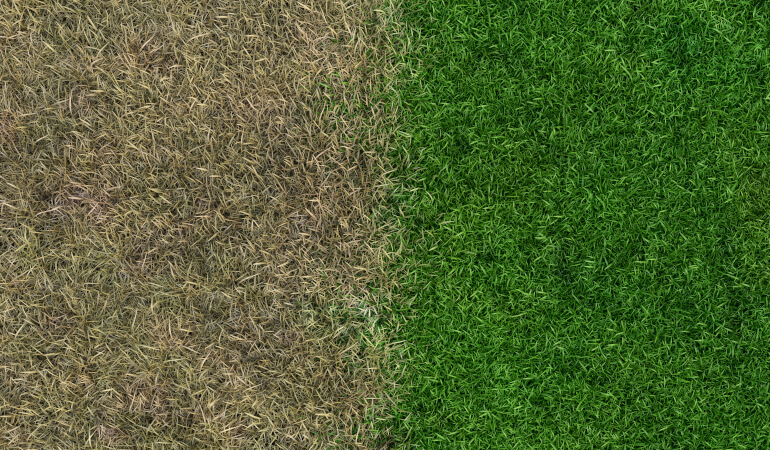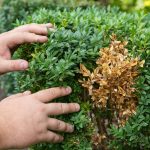Temperatures tend to go to extreme heights during the summer and that can cause drought stress to lawns and gardens. You may be wondering why your lawn is turning brown or whether you can revive dead grass in any way.
There are several steps you can take to try to help grass recover successfully from a drought. First, though, you have to be able to recognise the signs of summer lawn stress, as pests and other factors could also be the culprit behind your lawn’s poor health.
Table of Contents
What could cause dry grass?
As temperatures rise, grass turns brown and withers. There are several things to look for to determine what causes stress to your grass and why it may be turning brown.
Drought lawn stress
Just like any other plant in your garden, grass is susceptible to drought. The constant lack of water causes wilting and browning. Here’s how to detect drought lawn stress:
- Find a brown patch of grass and try to pull it. If it stays firmly rooted into the soil and can’t be pulled out, then it’s brown due to drought.
- Check the moisture and hardness of the soil underneath your lawn using a screwdriver, or garden spade. Push it into the dirt around brown and green patches of grass. If it goes in easily and comes out damp around green grass, but can’t penetrate the soil around brown patches then it’s too dry.
- Take a general look at your lawn. Is the whole grass brown or are there green and brown patches? If drought is the main cause for lawn stress, there should be brown spots here and there, usually in areas with direct sun and little to no access to water.
- Another early sign of drought stress is that your footprints remain in the grass when you walk over it. Wilted grass blades are another telltale sign your lawn is in desperate need of water.
Grass dormancy
You may not know it but grasses can go into dormancy just like any other seasonal plant. Grass dormancy occurs in long, dry periods. Cool-season grasses go into dormancy during the summer and revive in autumn, while warm-seasoned grasses go dormant in the cold weather when the temperatures drop. Both types of grass remain alive during the dormant period and return to life when the right temperatures and conditions occur.
If a lawn doesn’t receive enough water, it will go dormant in order to protect the crown and the roots from stress damage. If it still receives little, sufficient amounts of moisture, it will remain green, but the grass blades will stop growing. If it turns brown, don’t water it unless you intend to provide irrigation throughout the whole period of drought.
Lawn turning brown due to insects
Your green lawn can quickly turn brown if it’s attacked by pests. Some insects target the roots, while others munch on the grass blades. In order to find out if the grassroots are under attack, you have to pull a brown patch of grass from the ground.
If the patch comes out easily from the soil and there are almost no roots, then you might be dealing with white grubs. If there are patches of grass that look shorter as if they’ve been mowed too closely, then your lawn is under attack by insects that eat grass blades.
Dead grass
It’s hard to determine whether a lawn is in dormancy or if it’s dead. Especially during a hot summer or cold winter as grass goes dormant as a defence mechanism. If you suspect your lawn is dead due to drought, all you have to do is water it regularly. If it turns green slowly and steadily, without brown patches, then it was in dormancy. If there are still brown patches left, the grass there is already dead and you’ll have to replace it.
On the other hand, it’s hard to determine if your lawn is in dormancy or dead during the winter. It’s better to wait for spring to come and do its magic. If it turns green, it’s all good. But if it remains brown, wilted and ugly-looking, then you have to think about laying a new lawn or reseeding.
Grass turning brown due to diseases and weeds
Drought and hot temperatures are the perfect conditions for lawn diseases and weeds to spread. Grass becomes weaker due to the lack of moisture and diseases spread easier and faster. Your lawn might be turning brown because of this.
Will grass recover from drought?
A lawn can bounce back from drought with the right combination of care and patience. Especially if we are looking at a well-established turf with a well-developed root system. The deep roots should be able to survive the harsh weather conditions and help develop new green blades once the conditions improve.
Still, there are things you can do to help that process and restart your lawn as soon as possible.
Ways to help grass bounce back after drought
You can easily revive a brown lawn in the autumn. The weather provides the perfect growing conditions and the stress factors are almost zero.
Aerate the soil to help water get to the roots
The soil hardens after a drought period, so putting holes through it will create paths for moisture to get back into it and revive your lawn’s rooting system. It’s best to aerate before watering, using a garden fork or spade. Punch small holes in the soil in order to help water reach deeper.
Water well
The most important thing that can help rejuvenate grass is, of course, water. If your lawn is dormant, it will need deep and substantial watering to awaken.
Avoid watering the lawn when the sun is high and strong. Instead, do it early in the morning, early evening or even at night. However, avoid watering at night when the temperatures drop or moss and diseases can develop.
Nourish the grass
If you are wondering whether you should feed a lawn after a drought, then rest assured that you won’t damage it by fertilising during its dormancy. However, the grass will not benefit fully from the application.
It’s better to avoid granulated fertiliser during a drought because it can volatilise into the air due to the lack of water. Apply only liquid fertilisers or withhold the lawn feed until the weather improves. In general, the best time to feed turf grasses is September, October, and even early November as the soil is moist enough and the temperatures aren’t too high.
Clear and overseed where necessary
Clear decaying plant material and brown patches of grass then reseed. If your lawn didn’t survive the drought, now’s the time to lay new turf. It will have enough time to develop a strong root system until next spring.
Mow rarely and let the glass blades grow longer
You can still cut grass during or after dry periods but make sure to raise the height of the blades and do it less frequently. This way you’ll avoid weakening the grass blades and allowing diseases to take over.
Higher mowing also allows the grass clippings to fall over the lawn and act as a mulch, retaining moisture in the soil and helping the grass grow healthier. However, make sure the clippings aren’t too big, or they’ll do the opposite and smother the grass.
Postpone the application of weed killers
Most commercial weed killers are most effective when the weeds are actively growing. Even though weeds grow better than grass during drought, their leaves still shrink and curl up. Fortunately, if you still decide to apply spray-on herbicides on weeds during drought, it shouldn’t cause damage to your lawn if it’s dormant.
However, it is still better to avoid the use of lawn weed killers on drought-affected and dead turf. Leave it until next spring when both grass and weeds have renewed their growth.
Avoid heavy foot traffic on the lawn
Try not to walk on summer-stressed lawns. The heat and lack of moisture are causing enough damage to the grass blades. Heavy foot traffic compacts the soil and prevents water and air from entering it. Thus, hindering proper grass growth.
How long does grass take to recover after drought?
The timeline for grass recovery is not set in stone; it may range from as little as 2-3 weeks to 3 months, largely depending on the type of grass and severity of the drought. However, it’s not simply a matter of time—nurturing soil health and providing proper and regular care will also contribute significantly to faster recovery.
How to prevent drought lawn damage
There’s no way to certainly prevent drought and the damage that goes along with it. However, you can save your lawn from browning and death with proper care.
It’s important to establish an adequate maintenance program for each season. Different seasons and temperatures require different lawn care.
***
Did you find this article helpful and worth sharing? Or do you have any other interesting ideas on how to improve your front garden look? Then, please, tell us about them in the comment box below!




